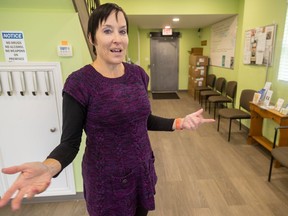
A Strathroy doctor is shutting her addiction treatment clinic after 12 years, blaming her dwindling patient count on the rise of safe drug supply programs that prescribe opioids to the highest-risk users.
Advertisement 2
Article content
Janel Gracey will be closing her methadone and suboxone treatment clinic at 58 Front St. in Strathroy at the end of April, a location that has seen her daily patient count decline to 30 at most from as many as 55.
Article content
“It just breaks my heart to have to close,” Gracey said. “The number of patients has been declining to the point where I’m not even breaking even anymore.”
Gracey prescribes and administers opioid agonist treatments at her Strathroy clinic, including methadone, suboxone and sublocade, a monthly injection. These addiction treatment drugs prevent withdrawal symptoms, stop patients from craving opioids and blunt the high users get from opioids if they do use.
Safe supply programs provide prescription opioids to high-risk drug users in a bid to prevent them from using toxic street drugs, including oft-deadly fentanyl. The goal is to stabilize these marginalized patients as they find housing, mental health treatment or other supports.
Advertisement 3
Article content
Gracey is concerned that, over time, people struggling with addiction are choosing not to pursue traditional treatment drugs and are instead sourcing diverted safe supply drugs on the street or seeking out safe supply prescribers who do not have stringent safeguards and wrap-around supports in place .
While she sees a place for safe supply in the landscape of addiction treatment, Gracey said she is concerned that the programs have expanded to include patients well outside the high-risk population they were once designed to serve.
“It was supposed to be for this extreme, small handful of people who could never get to the clinic, were constantly dropping out of methadone programs. It’s turned into a free-for-all,” she said.
Advertisement 4
Article content
“If you offer someone with an opioid addiction methadone, suboxone or dilaudid, what one do you think they’ll pick? They’ll pick dilaudid. Why can’t suboxone be the safe supply? Why can’t methadone?”
She is most concerned about safe supply prescribers working independently of clinicians that provide robust supports and monitoring and the potential for diversion of these prescription opioids to the streets.
Gracey, who works one day a week at her Strathroy location but is at clinics in St. Thomas and London on other days, is giving her patients the option of continuing to see her in one of the other neighboring cities.
Her Strathroy rapid access to addiction medicine (RAAM) clinic also provided Hepatitis C treatment and connected patients to a counselor from the Canadian Mental Health Association. Since less than 10 per cent of her patients have a family doctor, Gracey said she also tended to her patients’ primary care needs, too
Advertisement 5
Article content
She had attempted to look for other doctors or medical professionals to share the cost of the clinic space, but was unsuccessful. Her Strathroy office is set to close April 30.
Recommended from Editorial
While it is disappointing to see the loss of any addiction treatment service in the London region, drawing a direct causal link to safe supply is difficult, said Greg Nash, director of complex urban health at London InterCommunity Health Center (LIHC).
Just under 280 are involved in LIHC’s safe supply program, which provides prescription opioids, health care and other intensive social supports to patients. None has access to a car to get them between Strathroy and London, Nash said.
Advertisement 6
Article content
The safer supply program at LIHC began in 2016 as an urgent intervention for drug users whose addiction to street drugs put them at imminent risk of deadly overdoses. The criteria for patients eligible for safe supply has not changed, Nash said.
“We’re serving a population that has tried various forms of abstinence, addiction medicine and addiction treatment programs,” he said, adding the people in the program are chronic, long-term drug users.
“They have chronic homelessness and chronic poverty, concurrent mental health issues and two or more severe, chronic medical issues. We’re serving a very acute population.”
Patients in the LIHC program are using either illicit, street level fentanyl or crystal methamphetamine, he said.
Advertisement 7
Article content
Nash said there may be other clinicians prescribing hydromorphone, which goes by the brand name dilaudid, to drug users, but they are not the standard-bearer for the safe supply model.
“Those clinics might be more focused on the same population, in some cases, that RAAM clinics will often serve,” Nash said. “Those virtual clinics don’t provide the comprehensive wrap-around supports that are needed for the very rarified, specific population we’re serving.”
Safe supply has come under fire recently, attracting attention and criticism from national news media and federal politicians. But debate about safe supply shouldn’t come at the cost of discussion on the bigger picture of addiction treatment availability, Nash said.
Advertisement 8
Article content
“The conversation has become hyper-focused on one small approach that is targeted for a very specific audience,” he said. “We need all kinds of different treatment modalities and all kinds of different care supports to help people work through that.”
Gracey, whose mother struggled with alcoholism, said she was drawn to this work after beginning her career working with complex patients.
“I know what addiction does to people and to their families. When you see someone come out of that, it’s a big change,” she said. “It’s a huge joy in my heart because you see someone get their kids back, get housing, get a job. They totally turn their lives around. It’s what I live for.”
Article content

